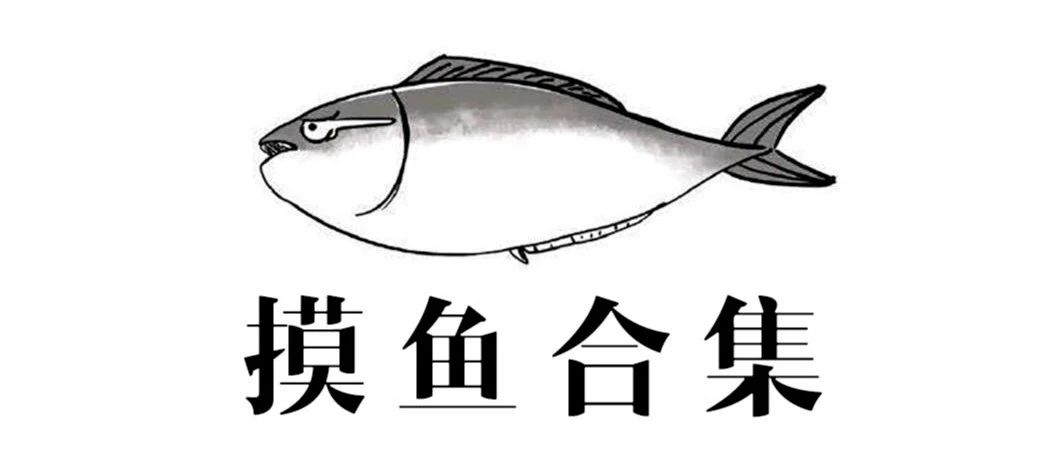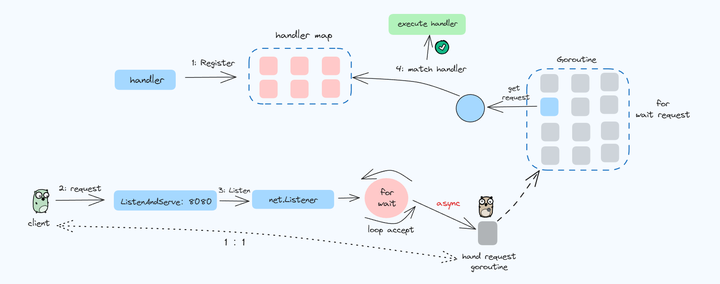go http 服务器编程(2)
go http 服务器编程(2)
match 会遍历路由信息字典,找到所有匹配该路径最长的那个。路由部分的代码解释就到这里了,最后回答上面的一个问题:http.HandleFunc 和 ServeMux.HandlerFunc 是什么关系?
// Handle registers the handler for the given pattern
// in the DefaultServeMux.
// The documentation for ServeMux explains how patterns are matched.
func Handle(pattern string, handler Handler) { DefaultServeMux.Handle(pattern, handler) }
// HandleFunc registers the handler function for the given pattern
// in the DefaultServeMux.
// The documentation for ServeMux explains how patterns are matched.
func HandleFunc(pattern string, handler func(ResponseWriter, *Request)) {
DefaultServeMux.HandleFunc(pattern, handler)
}原来是直接通过 DefaultServeMux 调用对应的方法,到这里上面的一切都串起来了!
Request
最后一部分,要讲讲 Handler 函数接受的两个参数:http.Request 和http.ResponseWriter。
Request 就是封装好的客户端请求,包括 URL,method,header 等等所有信息,以及一些方便使用的方法:
// A Request represents an HTTP request received by a server
// or to be sent by a client.
//
// The field semantics differ slightly between client and server
// usage. In addition to the notes on the fields below, see the
// documentation for Request.Write and RoundTripper.
type Request struct {
// Method specifies the HTTP method (GET, POST, PUT, etc.).
// For client requests an empty string means GET.
Method string
// URL specifies either the URI being requested (for server
// requests) or the URL to access (for client requests).
//
// For server requests the URL is parsed from the URI
// supplied on the Request-Line as stored in RequestURI. For
// most requests, fields other than Path and RawQuery will be
// empty. (See RFC 2616, Section 5.1.2)
//
// For client requests, the URL's Host specifies the server to
// connect to, while the Request's Host field optionally
// specifies the Host header value to send in the HTTP
// request.
URL *url.URL
// The protocol version for incoming requests.
// Client requests always use HTTP/1.1.
Proto string // "HTTP/1.0"
ProtoMajor int // 1
ProtoMinor int // 0
// A header maps request lines to their values.
// If the header says
//
// accept-encoding: gzip, deflate
// Accept-Language: en-us
// Connection: keep-alive
//
// then
//
// Header = map[string][]string{
// "Accept-Encoding": {"gzip, deflate"},
// "Accept-Language": {"en-us"},
// "Connection": {"keep-alive"},
// }
//
// HTTP defines that header names are case-insensitive.
// The request parser implements this by canonicalizing the
// name, making the first character and any characters
// following a hyphen uppercase and the rest lowercase.
//
// For client requests certain headers are automatically
// added and may override values in Header.
//
// See the documentation for the Request.Write method.
Header Header
// Body is the request's body.
//
// For client requests a nil body means the request has no
// body, such as a GET request. The HTTP Client's Transport
// is responsible for calling the Close method.
//
// For server requests the Request Body is always non-nil
// but will return EOF immediately when no body is present.
// The Server will close the request body. The ServeHTTP
// Handler does not need to.
Body io.ReadCloser
// ContentLength records the length of the associated content.
// The value -1 indicates that the length is unknown.
// Values >= 0 indicate that the given number of bytes may
// be read from Body.
// For client requests, a value of 0 means unknown if Body is not nil.
ContentLength int64
// TransferEncoding lists the transfer encodings from outermost to
// innermost. An empty list denotes the "identity" encoding.
// TransferEncoding can usually be ignored; chunked encoding is
// automatically added and removed as necessary when sending and
// receiving requests.
TransferEncoding []string
// Close indicates whether to close the connection after
// replying to this request (for servers) or after sending
// the request (for clients).
Close bool
// For server requests Host specifies the host on which the
// URL is sought. Per RFC 2616, this is either the value of
// the "Host" header or the host name given in the URL itself.
// It may be of the form "host:port".
//
// For client requests Host optionally overrides the Host
// header to send. If empty, the Request.Write method uses
// the value of URL.Host.
Host string
// Form contains the parsed form data, including both the URL
// field's query parameters and the POST or PUT form data.
// This field is only available after ParseForm is called.
// The HTTP client ignores Form and uses Body instead.
Form url.Values
// PostForm contains the parsed form data from POST or PUT
// body parameters.
// This field is only available after ParseForm is called.
// The HTTP client ignores PostForm and uses Body instead.
PostForm url.Values
// MultipartForm is the parsed multipart form, including file uploads.
// This field is only available after ParseMultipartForm is called.
// The HTTP client ignores MultipartForm and uses Body instead.
MultipartForm *multipart.Form
...
// RemoteAddr allows HTTP servers and other software to record
// the network address that sent the request, usually for
// logging. This field is not filled in by ReadRequest and
// has no defined format. The HTTP server in this package
// sets RemoteAddr to an "IP:port" address before invoking a
// handler.
// This field is ignored by the HTTP client.
RemoteAddr string
...
}Handler 需要知道关于请求的任何信息,都要从这个对象中获取,一般不会直接修改这个对象(除非你非常清楚自己在做什么)!
ResponseWriter
ResponseWriter 是一个接口,定义了三个方法:
Header():返回一个 Header 对象,可以通过它的Set()方法设置头部,注意最终返回的头部信息可能和你写进去的不完全相同,因为后续处理还可能修改头部的值(比如设置Content-Length、Content-type等操作)Write(): 写 response 的主体部分,比如html或者json的内容就是放到这里的WriteHeader():设置 status code,如果没有调用这个函数,默认设置为http.StatusOK, 就是200状态码
// A ResponseWriter interface is used by an HTTP handler to
// construct an HTTP response.
type ResponseWriter interface {
// Header returns the header map that will be sent by WriteHeader.
// Changing the header after a call to WriteHeader (or Write) has
// no effect.
Header() Header
// Write writes the data to the connection as part of an HTTP reply.
// If WriteHeader has not yet been called, Write calls WriteHeader(http.StatusOK)
// before writing the data. If the Header does not contain a
// Content-Type line, Write adds a Content-Type set to the result of passing
// the initial 512 bytes of written data to DetectContentType.
Write([]byte) (int, error)
// WriteHeader sends an HTTP response header with status code.
// If WriteHeader is not called explicitly, the first call to Write
// will trigger an implicit WriteHeader(http.StatusOK).
// Thus explicit calls to WriteHeader are mainly used to
// send error codes.
WriteHeader(int)
}实际上传递给 Handler 的对象是:
// A response represents the server side of an HTTP response.
type response struct {
conn *conn
req *Request // request for this response
wroteHeader bool // reply header has been (logically) written
wroteContinue bool // 100 Continue response was written
w *bufio.Writer // buffers output in chunks to chunkWriter
cw chunkWriter
sw *switchWriter // of the bufio.Writer, for return to putBufioWriter
// handlerHeader is the Header that Handlers get access to,
// which may be retained and mutated even after WriteHeader.
// handlerHeader is copied into cw.header at WriteHeader
// time, and privately mutated thereafter.
handlerHeader Header
...
status int // status code passed to WriteHeader
...
}它当然实现了上面提到的三个方法,具体代码就不放到这里了,感兴趣的可以自己去看。
6. 扩展
虽然 net/http 提供的各种功能已经满足基本需求了,但是很多时候还不够方便,比如:
- 不支持 URL 匹配,所有的路径必须完全匹配,不能捕获 URL 中的变量,不够灵活
- 不支持 HTTP 方法匹配
- 不支持扩展和嵌套,URL 处理都在都一个
ServeMux变量中
虽然这些都可以自己手动去码,但实在很不方便。这部分看看有哪些三方的包,都提供了哪些额外的功能。
alice
alice 的功能很简单——把多个 handler 串联起来,有请求过来的时候,逐个通过这个 handler 进行处理。
alice.New(Middleware1, Middleware2, Middleware3).Then(App)Gorilla Mux
Gorilla 提供了很多网络有关的组件, Mux 就是其中一个,负责 HTTP 的路由功能。这个组件弥补了上面提到的 ServeMux 的一些缺陷,支持的功能有:
- 更多的匹配类型:HTTP 方法、query 字段、URL host 等
- 支持正则表达式作为 URL path 的一部分,也支持变量提取功能
- 支持子路由,也就是路由的嵌套,
SubRouter可以实现路由信息的传递 - 并且和
ServeMux完全兼容
r := mux.NewRouter()
r.HandleFunc("/products/{key}", ProductHandler)
r.HandleFunc("/articles/{category}/", ArticlesCategoryHandler)
r.HandleFunc("/articles/{category}/{id:[0-9]+}", ArticleHandler)httprouter
httprouter 和 mux 一样,也是扩展了自带 ServeMux 功能的路由库。它的主要特点是速度快、内存使用少、可扩展性高(使用 radix tree 数据结构进行路由匹配,路由项很多的时候速度也很快)。
package main
import (
"fmt"
"github.com/julienschmidt/httprouter"
"net/http"
"log"
)
func Index(w http.ResponseWriter, r *http.Request, _ httprouter.Params) {
fmt.Fprint(w, "Welcome!\n")
}
func Hello(w http.ResponseWriter, r *http.Request, ps httprouter.Params) {
fmt.Fprintf(w, "hello, %s!\n", ps.ByName("name"))
}
func main() {
router := httprouter.New()
router.GET("/", Index)
router.GET("/hello/:name", Hello)
log.Fatal(http.ListenAndServe(":8080", router))
}negroni
http middleware 库,支持嵌套的中间件,能够和其他路由库兼容。同时它也自带了不少 middleware 可以使用,比如Recovery、Logger、Static。
router := mux.NewRouter()
router.HandleFunc("/", HomeHandler)
n := negroni.New(Middleware1, Middleware2)
// Or use a middleware with the Use() function
n.Use(Middleware3)
// router goes last
n.UseHandler(router)
http.ListenAndServe(":3001", n)7. 参考
这篇文章参考了以下资料:
- golang net/http 官方文档
- net/http 源码
- A Recap of Request Handling in Go
- Not Another Go/Golang net/http Tutorial
- the http handlerfunc wrapper technique in golang
- why do all golang url routers suck
本文来自:开源中国博客
感谢作者:柠檬酷
查看原文:go http 服务器编程
- Request
- ResponseWriter
- 6. 扩展
- alice
- Gorilla Mux
- httprouter
- negroni
- 7. 参考

腾讯云开发者

扫码关注腾讯云开发者
领取腾讯云代金券
Copyright © 2013 - 2025 Tencent Cloud. All Rights Reserved. 腾讯云 版权所有
深圳市腾讯计算机系统有限公司 ICP备案/许可证号:粤B2-20090059 深公网安备号 44030502008569
腾讯云计算(北京)有限责任公司 京ICP证150476号 | 京ICP备11018762号 | 京公网安备号11010802020287
Copyright © 2013 - 2025 Tencent Cloud.
All Rights Reserved. 腾讯云 版权所有











